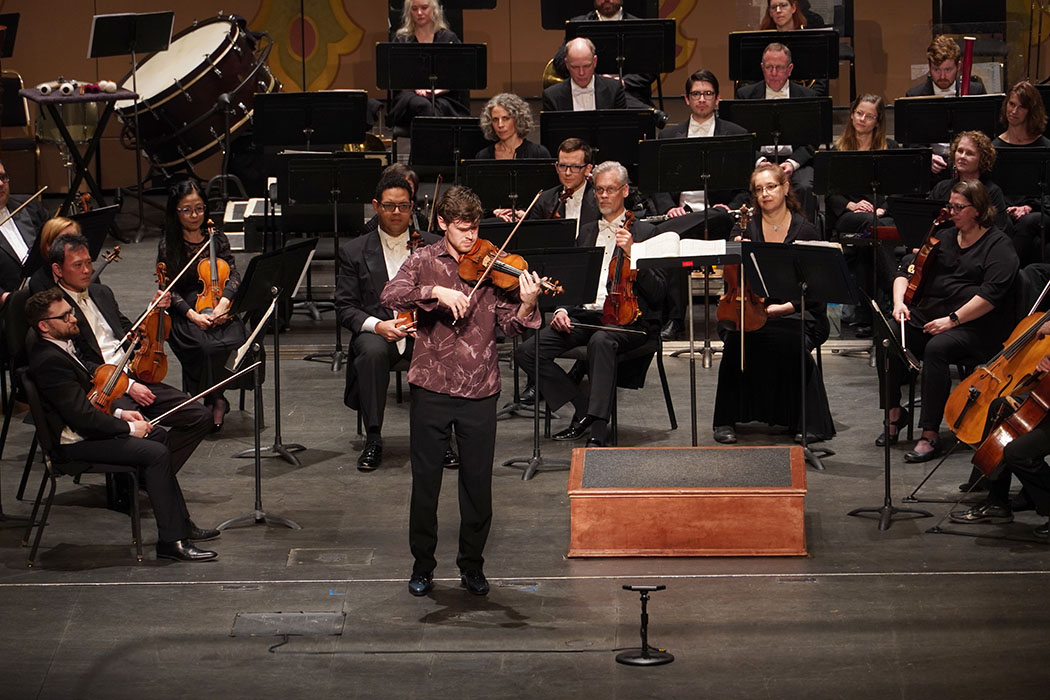If art thrives on turmoil and risk-taking—which is often the case—it should come as no surprise that the Knoxville Symphony Orchestra, last week faced with the turmoil of a last-minute soloist cancellation, would find an exciting and artful solution. With just days before concert rehearsals were due to begin, the KSO’s February Masterworks plans were thrown into disarray when the scheduled soloist in the Brahms Violin Concerto, violinist Philippe Quint, had to withdraw. A search ensued to find a replacement soloist for the concert—with the result being the booking of Canadian-born violinist Blake Pouliot who would perform the Mendelssohn Violin Concerto in E minor. Since the Mendelssohn concerto is ten-plus minutes shorter than the Brahms, KSO Maestro Aram Demirjian decided to keep some Brahms on the bill, opening with the Academic Festival Overture, Op. 80. William Dawson’s Negro Folk Symphony comprised the second half of the concert.
Admittedly, the spotlight was on Pouliot. While he may not yet have the name recognition of the violinist he replaced, that may soon be remedied. Pouliot approached this popular, oft-played concerto with an intelligent plan: start with simple, unadorned beauty of tone, adding in vocal-like accents of phrasing that define the melodic narrative, then end with an exciting tempo born of energy. Via the 1729 Guarneri del Gesù he plays, he has a substantial sound that meshed beautifully with the Tennessee Theatre’s warm resonance.
The soulfully played first movement cadenza was something of a signpost with Pouliot changing gears afterward, establishing momentum going into Mendelssohn’s imaginative “don’t applaud” segue between the Allegro and Andante movements. While it was the electric finale that churned up excitement and ripped the audience out of their seats for an ovation on Friday evening, it was his lyrical song-like phrasing that was the storyteller. Past the cadenza, past the nostalgic sweetness of the Andante, past the fairy-like textural combinations with woodwinds—Pouliot’s approach was at once natural, yet one that bubbled with the energy that showed up in his body language.
On Friday evening, Pouliot and Demirjian, building on their careful give and take throughout the piece, found a magic moment in the delivery of that finale—an accelerando on steroids, it seemed—in which orchestra and violinist each nudged the other faster and faster in tempo until the exhilaration was almost unbearably orgasmic. With this electric moment, I admit to a brief pang of quasi-schadenfreude for any KSO concertgoer who chose to sit out this concert.
Giving the audience and the orchestra a chance to catch their breath, Pouliot offered a charming and wistful encore: his own violin arrangement for the traditional Irish song, “The Last Rose of Summer.”
The universal reaction, it seems, to hearing William Dawson’s texturally rich Negro Folk Symphony is “I need to hear that one again!” That was certainly the audience reaction overheard repeatedly following the evening’s take by Maestro Demirjian and the orchestra. Unfortunately for music history, that was also the reaction to the work’s premiere by the Philadelphia Orchestra under Leopold Stokowski in 1934 at Carnegie Hall. Critical commentary used phrases like “the most distinctive and promising…” at a time when the American music world yearned for things that were distinctively American. Sadly, though, within a couple of years, interest in Dawson’s symphonic effort had fallen off—yet another example of the tragedy of lost opportunities for African-American composers. A substantial re-awakening of interest was rekindled only in the last three years, spurred on by a Naxos recording by the ORF Vienna Radio Symphony Orchestra.
The three-movement work oozes with themes popularly known as spirituals and traditional melodies, but the beauty of the composition lies in the advanced degree to which Dawson built on them, imbuing them with complex instrumental textures and rhythms.
In addition to the smorgasbord of musical textures Dawson offers up to the listener, there is a feast of thematic solos for the orchestra’s players. A horn solo, played beautifully by KSO principal horn Jeffery Whaley, opens the work’s first movement “The Bond of Africa.” A traditionally slow second movement follows, “Hope in the Night,” that features the poignant wistfulness of the English horn (Jennifer Ownby). The third movement “Oh, Le’ Me Shine, Shine Like a Morning Star!” is filled with thematic assertions from oboe (Claire Chenette), flute (Devan Jaquez), clarinet (Gary Sperl), and violin (Concertmaster William Shaub). A renewed use of percussion instruments as textural layers emerged when Dawson revised the work in 1952.
Ironically, on a concert that originally was to feature a major work by Brahms, the German master had to be satisfied with a playing of his Academic Festival Overture as the opening work of the evening. With it being added in at the last minute amid the turmoil of a soloist replacement, a listener might logically expect that it not get the attention it deserves. Happily, by Friday evening with everyone’s anxiety assuaged, the work was not only as exuberant and a bit boisterous as one expects, but also a rich and solidly played opener to a memorable and satisfying evening.








